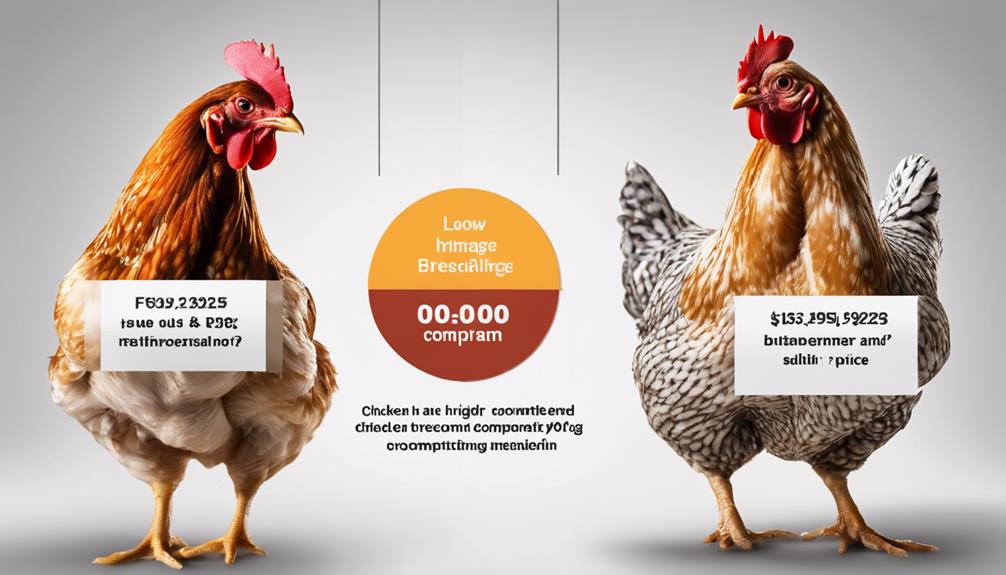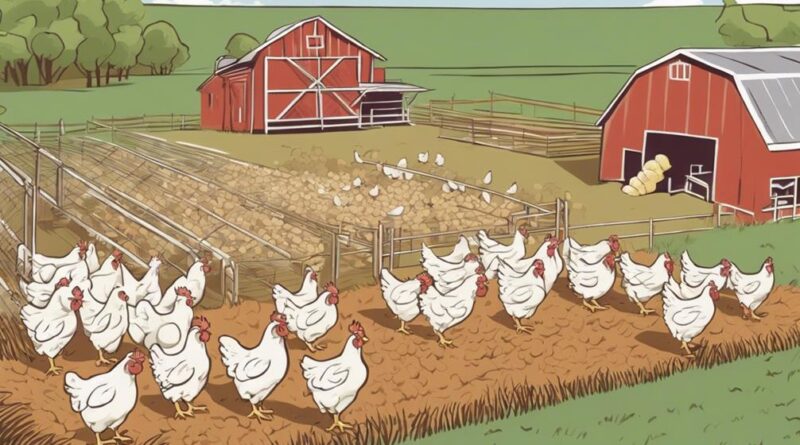What Determines the Profitability of Chicken Breeding?"
To maximize profitability in chicken breeding, assess market demand, manage costs efficiently, prevent diseases, maintain high-quality breeding stock, optimize housing and equipment, streamline labor costs, strategize pricing, and consider seasonal variations. These factors like demand analysis, cost efficiencies, stock quality, and planning are key to success in this industry. Understanding these aspects will improve your chances of running a profitable chicken breeding operation.
Market Demand Analysis
Analyzing the market demand for chicken breeding is crucial to understanding the potential profitability of this venture. To determine the viability of entering the chicken breeding industry, one must delve into pricing trends, consumer preferences, conduct market research, and forecast demand accurately.
Pricing trends play a significant role in the profitability of chicken breeding. By examining historical data and current market prices for various chicken breeds, you can identify patterns that may affect your pricing strategy. Understanding how prices fluctuate based on factors such as breed popularity, seasonality, and consumer demand is essential for setting competitive yet profitable prices.
Consumer preferences are another key aspect to consider when analyzing market demand for chicken breeding. Conducting surveys or studying existing data on consumer behavior towards different chicken products can provide valuable insights. By aligning your breeding practices with popular preferences such as organic, free-range, or specific breed characteristics, you can cater to a wider market and potentially command premium prices.
Market research and demand forecasting are vital tools in gauging the potential profitability of chicken breeding. Utilizing techniques like trend analysis, surveys, and consulting industry reports can help you make informed decisions. Accurately forecasting demand based on demographic shifts, economic indicators, and consumer behavior trends will enable you to plan production levels effectively and meet market needs efficiently. By staying attuned to pricing trends, consumer preferences, and conducting thorough market research, you can position your chicken breeding venture for success in a competitive market.
Cost of Feed and Supplies
When considering the profitability of chicken breeding, it's essential to meticulously assess the expenses associated with the cost of feed and supplies. One crucial factor to evaluate is feed efficiency, which directly impacts the overall cost of raising chickens. Feed efficiency refers to how effectively chickens convert feed into body weight, eggs, or meat. By focusing on improving feed efficiency through the selection of high-quality feeds and appropriate feeding practices, breeders can reduce costs and enhance profitability.
Another key aspect to consider is supply chain optimization. Optimizing the supply chain involves streamlining the process of sourcing, purchasing, and managing feed and supplies. By establishing efficient supply chain management practices, breeders can minimize costs associated with transportation, storage, and procurement. This optimization can lead to cost savings and improved overall financial performance.
Research shows that a significant portion of the expenses in chicken breeding is attributed to feed and supply costs. Therefore, implementing strategies to enhance feed efficiency and optimize the supply chain is crucial for maximizing profitability. By carefully monitoring and managing these expenses, breeders can achieve better financial outcomes and sustainable business growth.
Disease Prevention and Management
To maximize profitability in chicken breeding, a strategic focus on disease prevention and management is imperative for sustainable business growth. Implementing a well-designed vaccination schedule is crucial to shield your flock from common diseases. Vaccines are a cost-effective method to safeguard your chickens against potential outbreaks, reducing the need for expensive treatments down the line. Moreover, strict biosecurity measures are essential to prevent diseases from entering your farm. By controlling access to your facilities, monitoring visitors, and disinfecting equipment, you can significantly minimize the risk of disease transmission.
In the event of disease outbreaks, having robust treatment protocols in place is vital. Prompt identification of symptoms and quick initiation of appropriate treatments can make a significant difference in the outcome. Work closely with a veterinarian to establish effective treatment plans tailored to the specific diseases prevalent in your region. Additionally, investing in regular health checks for your flock can help detect potential issues early on, allowing for timely intervention.
Breeding Stock Quality
Effective breeding stock quality is a cornerstone of successful chicken breeding operations, influencing overall productivity and genetic diversity. When it comes to maximizing profitability in chicken breeding, the quality of breeding stock plays a crucial role. Here are some key factors to consider:
- Genetic Selection: Careful genetic selection is paramount in breeding stock quality. Choosing breeding stock with desirable traits such as high egg production, growth rate, and disease resistance can significantly impact the success of the breeding program.
- Health Maintenance: Ensuring the health of the breeding stock is essential for maintaining quality. Regular health checks, vaccinations, and a clean living environment are crucial to prevent the spread of diseases and maintain the overall well-being of the breeding stock.
- Breeding Stock Age: The age of the breeding stock can also influence the quality of offspring produced. Younger breeding stock may produce healthier chicks with better growth potential, while older breeding stock might have lower fertility rates and a higher risk of genetic abnormalities.
- Genetic Diversity: Maintaining genetic diversity within the breeding stock is vital for the long-term success of the breeding program. Avoiding inbreeding and periodically introducing new genetic lines can help prevent genetic abnormalities and improve overall productivity.
Housing and Equipment Expenses
Considering the impact of breeding stock quality on profitability, an examination of housing and equipment expenses is imperative in optimizing operational costs and efficiency in chicken breeding. Maintenance costs play a pivotal role in the overall expenses incurred in chicken breeding operations. Regular maintenance of chicken coops, feeding systems, waterers, and ventilation systems is essential to ensure the well-being of the flock and prevent costly repairs in the future. By investing in proactive maintenance measures, such as regular inspections and timely repairs, you can minimize unexpected breakdowns and prolong the lifespan of your equipment, ultimately reducing long-term maintenance costs.
Furthermore, equipment upgrades can significantly impact the efficiency and productivity of your chicken breeding operation. Upgrading to more advanced equipment, such as automated feeding systems or climate-controlled coops, can streamline daily tasks, improve resource utilization, and enhance overall output. While initial investment costs may be higher for advanced equipment, the long-term benefits in terms of labor savings, improved feed conversion rates, and better flock health often outweigh the upfront expenses. Therefore, carefully evaluating the potential return on investment of equipment upgrades is crucial in maximizing profitability in chicken breeding. Remember, efficient housing and well-maintained equipment are key drivers of success in the poultry industry.
Labor Costs and Efficiency
Investing in optimizing labor costs and efficiency is essential for maximizing profitability in chicken breeding operations. Efficient management of labor resources can significantly impact the overall financial health of a chicken breeding business. To ensure profitability, here are some key factors to consider:
- Implementing Time Tracking Systems: Utilizing technology to track employee hours and tasks can provide valuable insights into labor efficiency and help identify areas for improvement.
- Training Programs: Investing in training for employees can enhance their skills and productivity, ultimately leading to cost savings and increased efficiency.
- Performance Incentives: Introducing performance-based incentives can motivate workers to be more productive and result in higher overall efficiency.
- Outsourcing Non-Core Tasks: Consider outsourcing non-essential activities to specialized firms, which can often perform these tasks more efficiently and cost-effectively.
Pricing Strategy and Competition

To maximize profitability in chicken breeding operations, it's imperative to strategically analyze pricing and competitive dynamics within the market. Competitor analysis plays a crucial role in understanding the pricing strategies adopted by other players in the industry. By conducting a thorough competitor analysis, you can identify pricing trends, positioning strategies, and potential areas for differentiation. This information is vital for devising a pricing strategy that sets you apart from competitors while remaining attractive to customers.
Pricing optimization is a key component of a successful chicken breeding business. It involves setting prices at levels that maximize revenue and profit. To achieve pricing optimization, you need to consider factors such as production costs, market demand, and competitor pricing. By striking the right balance between these elements, you can ensure that your prices are competitive yet profitable.
When analyzing competitors, focus on both direct competitors – those offering similar products or services – and indirect competitors – those catering to the same customer needs through different means. Understanding how competitors price their products and the value they offer can help you position your chicken breeding business effectively in the market. By leveraging competitor analysis and implementing pricing optimization strategies, you can enhance your profitability and build a sustainable competitive advantage in the chicken breeding industry.
Seasonal Factors and Planning
Seasonal fluctuations in supply and demand significantly impact the planning and operational efficiency of chicken breeding businesses. Weather impact plays a crucial role in determining the breeding schedule, affecting the overall production cycle and market timing. Here are some key points to consider:
- Weather Impact:
Weather conditions such as temperature and humidity can influence the breeding process. Extreme weather can lead to lower egg production, affecting the overall output of the business.
- Breeding Schedule:
Planning the breeding schedule according to seasonal variations is essential. Adjusting the breeding cycles based on seasonal demand can help optimize production and meet market needs effectively.
- Production Cycle:
Understanding how seasonal factors affect the production cycle is vital for maintaining a steady supply of chickens. Planning ahead for seasonal changes can prevent disruptions in the production process.
- Market Timing:
Seasonal fluctuations can impact market demand for chicken products. Being aware of these trends and adjusting production and marketing strategies accordingly can help maximize profitability.
Frequently Asked Questions
How Does Weather Affect Chicken Breeding Profitability?
When considering the impact of weather on chicken breeding profitability, factors like climate conditions and production costs come into play. Seasonal fluctuations due to weather patterns can affect market demand for chicken products.
Extreme weather events may lead to increased production costs, impacting overall profitability. Monitoring weather forecasts and adapting breeding practices accordingly can help mitigate potential risks and ensure a more stable financial outcome.
What Impact Do Government Regulations Have on Chicken Breeding Profits?
When it comes to government regulations, you need to consider their impact on chicken breeding profits. Regulations can affect costs, production methods, and market access. Compliance expenses may rise due to stringent rules, reducing profitability.
Market competition can intensify if regulations favor larger producers, squeezing smaller operations. Analyzing how government regulations interact with market dynamics is crucial in understanding their influence on chicken breeding profitability.
Can Technological Advancements Improve Chicken Breeding Profitability?
When considering the impact of technological advancements on chicken breeding profitability, genetic selection and automation systems play pivotal roles.
Through genetic selection, breeders can enhance desirable traits in chickens, improving overall productivity and quality.
Automation systems streamline processes, reducing labor costs and increasing efficiency.
Are There Tax Incentives That Can Benefit Chicken Breeders Financially?
When considering tax incentives for chicken breeders, it's essential to explore how tax breaks can lead to significant financial benefits.
By taking advantage of deductions and credits tailored to agricultural activities, you can reduce your tax burden and increase profitability.
Understanding the specific tax incentives available for chicken breeding can positively impact your bottom line and provide a competitive edge in the industry.
Stay informed about tax regulations to maximize your financial gains.
How Do Global Market Trends Influence Chicken Breeding Profitability?
When examining how global market trends affect chicken breeding profitability, it's crucial to analyze demand fluctuations and pricing strategies. Understanding the impact of supply chain dynamics and distribution channels is essential.
Conclusion
In conclusion, profitability in chicken breeding is determined by various factors such as market demand, cost of supplies, disease prevention, breeding stock quality, housing expenses, labor efficiency, pricing strategy, and seasonal planning.
By carefully analyzing these elements and making strategic decisions, breeders can optimize their operations and maximize profitability.
It's crucial for breeders to stay informed, adapt to market trends, and continuously improve their practices to ensure long-term success in the industry.
